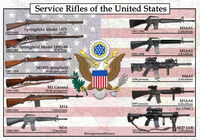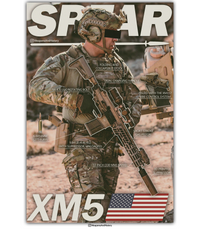History of American service rifles
History of American service rifles from 1873-2023
It all started with the Model 1873, the first standard issue breech loading rifle. The Model 1873 was chambered in .47-70-405. The rifle was adopted in 1873 and was still used during the American-Spanish war. In 1892 the rifle was getting replaced by the Springfield Model 1892. Bassicly a licensed copy of the Norwegian Krag-Jorgensen.
The Model 1892 is a bolt action using a side loading gate. Chambered in the .30-40 Krag. The rifle was well liked but it was inferior to the Spanish Mauser 1893. In both ballistics and rate of fire. In 1899 a new type of load for the .30-40 krag was issued, but in 1903, the Model 1892-99 was getting replaced by the M1903.
The M1903 springfield was officaly adopted in 1903, now being chambered in .30-06 and using a 5 round magazine which can now be fed using stripper clips instead of being manually loaded like the Model 1892-99. The M1903 was based of the Mauser 1893 and features a 24inch barrel to cut the idea between a infantry rifle and a carbine. The M1903 was primairily used during World War 1 and saw action in World War 2 too. In 1936 the M1903 was getting replaced by the M1
The M1, the iconic World War 2 rifle. The M1 Garand (named after its inventor) was America's first semi automatic rifle, and the first semi automatic rifle to be used on a large scale. The M1 is chambered in the .30-06 (same as the M1903) and is fed by using En-bloc clips. The rifle uses a long stroke gas piston and a 2 lug rotating bolt. The M1 Garand was used during World War 2 and there were over 5.4 million M1's made. General George Patton called it "the greatest battle implement ever devised." Semi automatic rifles were far superior over bolt action rifles used by the Axis powers. After World War 2 and at beginning of the North Atlantic Treaty Organization (NATO), a new standard cartridge and rifle needs to be developed. Which led to the M14
The M14 was adopted in 1958. Chambered in 7.62x51mm nato. The M14 itself is based of the M1 Garand, being mechanically and constructively similair. The M14 is fed by a 20 round box magazine and is select fire. The M14 saw action during the Vietnam War, where it was not received very well and was vastly inferior the AK and the assault rifle in general.
The U.S. Air force was looking for a new rifle to replace their M2 carbines for troops guarding airbases and aircraft, which ended up in adopting the AR-15 in 1962. The rifle was well liked by the USAF, but not so much by the US army. Long story short, in 1964 the US army and marine corps also decided to adopt the AR-15 under the designation M16. The M16 is chambered in the new intermediate 5.56x45mm round, uses stoners internal piston system and a multi lug rotating bolt. The M16 was 1.3kg lighter than the M14, because it was made using light weight materials. The original M16 had alot of controversy in the Vietnam war. Due to inproper instructions of cleaning and fielding cleaning kits and uncompatible ammuntion. Which led to alot of problems and unnecessary deaths.
We left with 72 men in our platoon and came back with 19, Believe it or not, you know what killed most of us? Our own rifle. Practically every one of our dead was found with his (M16) torn down next to him where he had been trying to fix it.
— Marine Corps Rifleman, Vietnam.
This led to the development of a new improved M16 variant., the M16A1. Which features a chromed chamber and barrel and a manual forward assist. Known on the M16A1 as the teardrop forward assist. And more smaller improvements. The M16A1 was later widely accepted by the US military and worked incredibly well.
In 1982, the M16A2 was adopted by the USMC and in 1986 by the US army. It featured a new round ribber handguard and a new stock and pistol grip, a brass deflector behind the ejection port, new rear sights, a new barrel and fully automatic setting was replaced by a 3 round burst setting. The US navy also adopted the M16A3 in small numbers, which is bassicly a M16A2 but with a fully automatic option instead of 3 rounds bursts.
In 1982, the U.S. Government requested a carbine version of the M16A2. Colt and the U.S. Government developed a new variant of the XM177E2, and the U.S. Army redesignated the XM177E2 to the XM4 Carbine in 1983, The XM4 was tested by the Army's Armament Research and Development Center (ARDC) in June 1983. Later, the gun was updated with improved furniture, and a new barrel that is 14.5 inches (368mm) long.
XM4 was finished in 1987, and the Marines adopted it with the designation "carbine, 5.56mm, M4."
In 1992, USSOCOM developed the Special Operations Peculiar Modification (SOPMOD) Block I kit for the carbines used by US Special Operations Forces. The kit features an M4A1, a Rail Interface System (RIS) by Knights Armanent, Trijicon ACOG and many more accessories.
The Army gave Colt its first contracts for M4’s 1993, and M4A1 carbines for SOCOM operators in February 1994.
The M4 Carbine first saw action in Kosovo in 1999. It would subsequently be used heavily by U.S. forces during the Global War on Terrorism, including in Operation Enduring Freedom and Operation Iraqi Freedom. In the Army, the M4 had largely replaced M16A2s as the primary weapon by 2005, but the Marine Corps, chose the full-sized M16A4 over the M4 as its standard infantry rifle, in 2015 that was however changed.
The U.S. Army later converted or replaced all M4’s with M4A1’s.
The M16A4 is the fourth generation of the M16 series. The iron sight/carrying handle assembly on the M16A2/M16A3 upper receiver, was replaced by a MIL-STD-1913 "Picatinny railed" flat-top upper receiver for mounting aiming optics or a removable iron sight/carrying handle assembly. The M16A4 rear aperture sights integrated in the Picatinny rail mounted carry handle assembly are adjustable from 300 m (328 yd) up to 600 m (656 yd), where the further similar M16A2 iron sights line can reach up to 800 m (875 yd). The FN M16A4, using safe/semi/three-round burst selective fire, became standard issue for the U.S. Marine Corps.
Military issue rifles were also equipped with a full length quad Knight's Armament Company M5 RAS Picatinny railed hand guard (that holds zero on the top rail), allowing vertical grips, lasers, tactical lights, and other accessories to be attached, coining the designation M16A4 MWS (or Modular Weapon System) in U.S. Army field manuals.
The M27 Infantry Automatic Rifle is standard issue rifle for the United States Marine Corps infantry. The M27 fills in both the role of a assault rifle and a squad automatic weapon. The rifle is manufactered by Heckler & Koch and is based of the HK416.
In 2005, the USMC started the infantry automatic rifle program, in search for a reliable light automatic rifle (think about it like a Light Support Weapon, RPK, C7LSW, L86 etc). The rifle needed to be lighter, able to take STANAG magazines, maneuverable and be similair to the infantry rifle. In 2009, HK won the contract.
The M27 was meant as a squad automatic weapon, and in 2011 it replaced the M249 SAW, and in 2017, the M27 replaced the M16A4 and M4A1 for the infantry riflemen, meaning all squad members gets issued the M27.
The M27 is based of the HK416, but with a heavier barrel for sustainable automatic fire, and since all infantrymen gets issued the M27, it increases the individual firepower by alot. But the firepower of a squad is debatable.
The M27 is chambered in 5.56x45mm NATO and uses a short stroke gas piston and a multi-lug rotating bolt (exact same operating system as the HK416). It feeds from 30 round stanag magazines. The M27 is issued with either a Trijicon Acog (4x illuminated optic) or Vcog (lvpo), a simple forgrip, bipod and suppressor (optionally). With all the gadgets on it, it comes in at 9.8lbs - 4.4kg.
Now the XM7 (formerly known as the XM5). A new battle rifle in 6.8x51mm for the US military? To answer that question, we just have to wait. It now looks like it is NOT going to be used on big scale.

